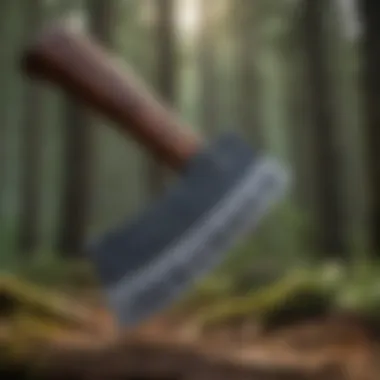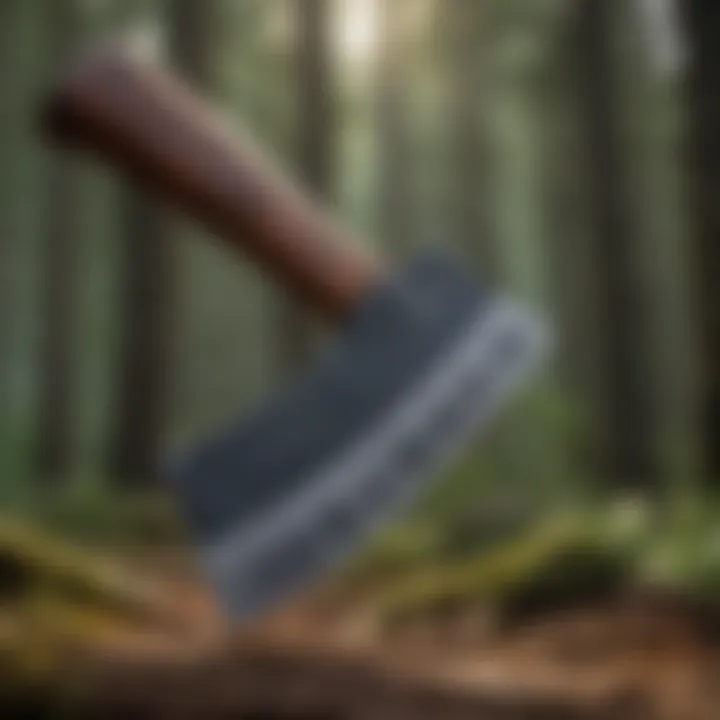The Ultimate Guide to Axe Sharpening Tools


Intro
Axe maintenance is crucial for anyone working in forestry or woodlands. A well-sharpened axe not only makes the task easier but also safer. This guide will delve into the best tools for sharpening axes, emphasizing their features, use cases, and how to select the one that fits your needs. In addition to introducing various sharpening methods, it will also highlight the significance of maintaining a sharp edge and present some maintenance tips.
Understanding Woodland Ecosystems
Woodlands are intricate ecosystems brimming with life and complexity. Understanding them is vital for effective axe maintenance and usage within these environments. A comprehensive grasp of woodland ecosystems involves recognizing the biodiversity in forests and the role they play in regulating our climate.
Importance of Biodiversity in Forests
Forests house countless species of trees, plants, and wildlife. Biodiversity is not just about variety; it also contributes to resilience against pests, diseases, and environmental changes. Managing axes with respect to biodiversity can lead to sustainable forestry practices that help maintain this delicate balance.
Role of Forests in Climate Regulation
Forests act as carbon sinks, absorbing significant amounts of carbon dioxide. They support the climate by regulating humidity and temperature. By understanding how to maintain and use your axe effectively in these environments, you can contribute to overall forest health and productivity.
Sustainable Forestry Practices
Adopting sustainable forestry practices is paramount in modern woodland management. These practices ensure the longevity of forests and the wildlife that depends on them.
Principles of Sustainable Forestry
Sustainable forestry principles guide the practices that support forest ecosystem health. They include:
- Continuous cover: Maintain a diverse mix of species and ages to promote ecological stability.
- Chain of custody: Traceability from forest to consumer, ensuring responsible sourcing.
- Minimal impact logging: Techniques that reduce environmental harm and promote regrowth.
Case Studies of Successful Implementations
Examining successful case studies can provide insights into effective practices:
- A study in the Amazon demonstrated reduced deforestation by implementing community-led forestry.
- In Scandinavia, sustainable practices have led to increased biodiversity and forest health.
Woodland Stewardship Techniques
Stewardship goes beyond simple management; it is about fostering a relationship with the land. Effective stewardship techniques can enhance the ecological health of woodlands.
Forest Management Plans
Developing a coherent forest management plan is essential. Such plans outline goals for sustainability, biodiversity, and productivity. Regular reviews ensure the plan stays relevant and reflects any changes in the ecosystem.
Conservation Strategies
Conservation strategies focus on protecting existing resources while fostering regeneration. Techniques include:
- Establishing wildlife corridors.
- Restoring degraded areas to enhance habitat quality.
- Engaging local communities to promote awareness and stewardship.
Effective axe sharpening and maintenance practices complement these stewardship efforts, allowing forestry professionals to work efficiently while preserving woodland integrity.
Prelude to Axe Sharpening


Axe sharpening is a fundamental skill that plays a significant role in ensuring tools remain effective for various tasks. Sharp axes not only improve efficiency but also enhance safety during use. Failing to maintain an axe can lead to unnecessary struggles and accidents. Therefore, understanding the process and tools required for sharpening is essential.
Importance of Sharpening an Axe
The act of sharpening an axe cannot be overemphasized. A sharp axe performs with precision, making clean cuts easier. This is critical in applications such as forestry work, where efficiency translates to productivity. Moreover, sharpening an axe helps maintain its edge, extending the lifespan of the tool. In the realm of outdoor activities, whether chopping wood for a fireplace or clearing a path through wilderness, a sharp axe can make tasks significantly more manageable.
Consequences of Dull Axes
Using a dull axe poses risks that can impact both the task and the user. A dull blade requires more force, leading to fatigue and a higher chance of losing control. This increases the likelihood of accidents, which can cause injuries. Additionally, having to exert more effort with a dull axe can result in damage to the wood being cut, leading to ineffectiveness in work. It is therefore clear that neglecting the sharpening process has tangible negative outcomes that can be easily avoided.
Types of Axe Sharpening Tools
Understanding the different types of axe sharpening tools is essential for both maintaining an effective cutting edge and ensuring safety during use. Each tool offers a unique set of features suitable for various applications. By familiarizing oneself with these tools, one can make informed decisions that enhance the overall sharpening experience. Below, we explore five common types of axe sharpening tools, discussing their characteristics, benefits, and typical use cases.
Whetstones
Whetstones are traditional tools for sharpening blades, including axes. They come in various grits, both coarse and fine, allowing for precision sharpening. A coarse grit is ideal for removing material quickly, which is beneficial when restoring a severely dull edge. Conversely, a fine grit contributes to a smoother finish. Using a whetstone requires some skill, as maintaining the correct angle during sharpening is crucial to achieving optimal results.
- Pros: Versatile, allows for customization of edge finish.
- Cons: Requires practice to master.
Honing Guides
Honing guides help maintain the correct angle while using various sharpening tools, including whetstones. This is particularly useful for individuals less experienced in sharpening techniques. By securing the axe in place, honing guides can yield consistent results with less effort. Some models come with adjustable angles, catering to different blade shapes.
- Pros: Ensures consistent angles, user-friendly for novices.
- Cons: Added cost and may limit portability.
Electric Sharpeners
Electric sharpeners offer convenience and speed, making them appealing options for those who sharpen axes routinely. These devices utilize abrasive wheels to grind away material quickly. While they offer efficient results, there is a risk of over-sharpening if not monitored closely. It is essential to choose models designed specifically for axes, as general-purpose sharpeners may not provide the desired results.
- Pros: Fast and efficient.
- Cons: Risk of over-sharpening, less control over sharpness.
Manual Sharpening Files
Manual sharpening files are an accessible option for many users. These files can be used to sharpen edges by hand and allow for precise control over the sharpening process. They are lightweight and portable, making them a preferred choice for outdoor enthusiasts. The experience gained through using a file can build sharpening skills effectively.
- Pros: Lightweight, portable, skill-building.
- Cons: Requires more time and effort compared to electric options.
Ceramic Sharpeners
Ceramic sharpeners provide a unique approach to sharpening. They are often used as finishing tools after the primary sharpening has taken place. The ceramic surface can help refine the edge, improving sharpness. They are usually compact and easy to use, making them valuable in a toolkit. It is worth noting that ceramic sharpeners work best on already honed edges—to restore a dull blade, combination with another sharpening method is recommended.
- Pros: Compact, perfect for finishing touches.
- Cons: Less effective on dull blades without prior sharpening.
Understanding these various axe sharpening tools allows users to select a method that aligns with their skill level, desired outcomes, and specific tasks. Each tool has its own set of benefits and drawbacks, making it vital to choose wisely based on personal preference and needs.
Choosing the Best Axe Sharpening Tool
Selecting the appropriate axe sharpening tool is crucial for maintaining the efficacy of your cutting implement. Each tool has unique features that cater to different axes and sharpening preferences. Misjudging your needs may lead to poor sharpening results and can even damage the axe itself. It is essential to consider various elements that play a role in your decision. The objective is to enhance the performance of your axe and extend its lifespan through regular maintenance.
Assessing Axe Type


To choose a suitable sharpening tool, first, identify the type of axe you own. Various axes serve different purposes, from felling trees to splitting logs. Each type requires specific considerations. For instance, a traditional axe might benefit from a whetstone for precise sharpening, while a hatchet may be efficiently maintained with a honing guide. Understanding the design and intended use of your axe will help you select a sharpening tool that aligns with its requirements. For heavy-duty axes, thicker sharpening surfaces may be necessary, while lighter axes require finer edges.
Evaluating Personal Experience Level
Your proficiency in axe maintenance should shape your choice of sharpening tool. If you are a novice, using tools that offer guidance, like honing guides, can improve your technique and prevent damage to the axe blade. Experienced users might prefer whetstones, as they offer greater control over the sharpening process. Assessing your skill level can help determine whether to invest in a more specialized tool or something more straightforward.
Considering Portability and Convenience
Portability and convenience are often overlooked yet essential factors. If you frequently work in remote locations or have limited storage, opting for lightweight and compact tools can make sharpening more manageable. Electric sharpeners might be efficient but may not be practical in all situations. A manual sharpening file or a small whetstone might be more appropriate for on-the-go sharpening. Evaluating your work environment can influence your choice, ensuring that your sharpening tool fits seamlessly into your workflow.
Step-by-Step Axe Sharpening Process
The process of sharpening an axe is vital for both effectiveness and safety. A properly sharpened axe cuts smoothly, requires less effort, and ultimately helps maintain a safer working environment. Through a structured approach, users can achieve optimal results, minimize errors, and extend the life of their axes. The techniques discussed below will guide both novices and experienced woodworkers in achieving a keen edge on their tools.
Preparation and Safety Measures
Before initiating the sharpening process, the importance of preparation cannot be overstated. Ensuring that the workspace is organized and safe is essential. Start by clearing the area of any obstacles that could lead to accidents. It is advisable to wear safety glasses and gloves, as they protect against accidental slips and debris. The axe should be secured in a vise or resting on a stable surface to prevent movement during sharpening.
"Safety is not just a policy; it’s a practice. Prioritize preparation to ensure your own wellbeing."
Check the axe for any visible defects. Look for cracks or severe rust that might compromise the axe's performance. If any damage is found, consider repairing it before sharpening. Gathering all necessary tools, such as sharpening stones, files, or guides, will streamline the process and minimize interruptions.
Using Whetstones Effectively
Whetstones are classic sharpening tools that can offer precision and control when used properly. Choosing the right grit is essential. Start with a coarser grit (around 400) for heavy sharpening, and progress to a finer grit (1000 to 3000) for honing the edge. Wetting the stone is also crucial as it reduces the risk of overheating the blade and helps in removing metal shavings effectively.
To sharpen the axe using a whetstone, position it at the appropriate angle, typically 20 to 25 degrees. Maintaining this angle while moving the axe across the stone is key to achieving a uniform edge. Use long, steady strokes and alternate sides to ensure an even sharpening. After several strokes, inspect the edge for any burrs and smooth them out with the finer grit.
Sharpening with Files and Guides
Files are another useful sharpening tool, especially for those looking for a straightforward method. A flat or half-round file can be utilized depending on the axe’s design. Ensure that the file is clean to avoid scratches on the blade. Begin by holding the file at the same angle as the axe edge and applying even pressure while pulling the file towards you.
Honing guides can enhance precision by maintaining a consistent angle. These devices fit over the axe edge and allow for controlled movement along sharpening stones or files. Using a guide can be particularly beneficial for newcomers who may struggle to maintain the angle manually. This consistency leads to improved sharpness and a more durable edge.
Maintaining an Edge with Electric Tools
Electric sharpeners have gained popularity for their efficiency and speed. They simplify the sharpening process for those with limited time or experience. However, to achieve the best results, it is vital to understand how to use them correctly. Begin with a high-quality electric sharpener, such as the Work Sharp Guided Field Sharpener. Set it up according to the manufacturer’s instructions.
Insert the axe into the sharpener and follow the direction of the blades. Electric sharpeners can be set at a fixed angle, working to quickly remove metal without excessive heat buildup. Make sure to monitor the progress frequently. After sharpening, inspect the edge visually; minor touch-ups may be needed using manual methods to achieve a precise finish.
In summary, mastering the sharpening process is an invaluable skill for axe users. Each step, from preparation to execution with various tools, contributes to an efficient working tool. Over time, this will enhance performance and ensure safety while working in forestry or any related field.
Maintenance of Sharpening Tools
Maintaining sharpening tools is essential to ensure their effectiveness and longevity. Regular maintenance practices enhance the performance of tools, allowing them to work optimally when you need them. Properly maintained sharpening tools can save time and resources while improving the overall sharpening experience. Without proper care, the tools might become less effective, leading to inefficient sharpening or potential damage.
Cleaning Practices
Cleaning your sharpening tools is a fundamental aspect of their maintenance. An unclean tool can harbor debris, residue, and contaminants that may affect the sharpening process. Here are some steps to consider:
- Regular Inspection: After each use, inspect the tool for any build-up. Look for metal shavings or sharpening compound remnants.
- Gentle Cleaning: Use a soft cloth or brush to remove debris. For tougher residue, warm soapy water can be effective. Ensure all parts are rinsed and dried properly.
- Avoid Harsh Chemicals: Stick to non-corrosive cleaning agents. Abrasive cleaners can damage the surfaces of your sharpening tools.


The process of cleaning is simple yet crucial. Keeping your tools clean not only maintains their functionality but also prolongs their lifespan. Regular use will keep you aware of when a deeper clean may be needed.
Storage Tips
Storing sharpening tools properly is another key aspect of maintenance practices. Tools that are not stored correctly can become damaged or contaminated. Here are some effective storage tips:
- Keep Dry: Always store tools in a dry environment to prevent rust or corrosion. A moisture-free area is essential.
- Use Cases and Covers: Utilize protective cases or covers for your tools. This minimizes exposure to dust and accidental impacts.
- Organized Storage: Arrange your tools systematically. Easy access prevents unnecessary handling that might damage the sharpening surfaces.
Following these storage tips will help ensure that your sharpening tools are ready for use when needed, without the worry of degradation from improper storage.
Proper maintenance of sharpening tools is an investment in time that translates into better performance and superior results.
Common Mistakes in Axe Sharpening
Axe sharpening is a skill that requires practice and knowledge. However, even experienced individuals can make errors that compromise the effectiveness of their sharpening efforts. Understanding these common mistakes is essential for achieving optimal axe performance. This section dives into frequent pitfalls that can lead to frustration and subpar results. By recognizing and avoiding these mistakes, users can ensure their axes remain sharp and effective for various tasks.
Over-sharpening
Over-sharpening occurs when unnecessary pressure is applied to the axe during the sharpening process. This can lead to a thinner blade edge over time. While aiming for a razor-sharp edge is important, too much sharpening can weaken the structure of the blade. Gradual and careful sharpening maintains the integrity of the axe.
"Avoid the temptation to sharpen more than necessary. A sharp axe doesn't require excessive grinding, but rather consistent maintenance."
To prevent over-sharpening, assess the blade's sharpness before sharpening again. Regularly inspect the edge for wear and only sharpen when you notice a decline in cutting ability. This method helps preserve the life of the axe while maintaining a functional edge.
Using Incorrect Angles
The angle at which you sharpen an axe blade significantly affects its performance. Most axes have a recommended sharpening angle, typically between 20 to 30 degrees. Deviating from this optimal angle can results in uneven wear and reduced cutting effectiveness. Holding the blade at the wrong angle can lead to both dulled edges and potential damage.
To determine the correct angle, use a protractor or angle guide. Alternatively, study the existing angle of the blade before sharpening. Ensure you maintain it throughout the sharpening process. Consistency is key when working with any axe.
Neglecting Regular Maintenance
Regular maintenance is crucial for the longevity of your sharpening tools and axe. Some users might sharpen only when they notice a decline in sharpness, neglecting to maintain the edge over time. This approach can compoud problems that could be fixed with periodic maintenance. Tools also require upkeep to prevent corrosion and ensure they work efficiently.
Maintenance strategies include:
- Cleaning: Keep tools cleen from metal shavings and debris.
- Oiling: Apply a light coat of oil to prevent rust on metal surfaces.
- Regular Inspection: Periodically check both axes and sharpening tools for wear.
By incorporating these maintenance practices, you can avoid common pitfalls and keep your axe and sharpening tools in optimal condition.
In summary, understanding and avoiding these common mistakes are essential for achieving effective axe sharpening. Sharpening an axe is not just about having the correct tools; it's also about knowledge and care. Adopting proper technique, using correct angles, and committing to regular maintenance will empower you to use your axe more effectively.
Closure: The Significance of Axe Care
Caring for axes is not merely a matter of personal preference. It is essential for operational efficiency and user safety. A well-maintained axe is a tool that performs as intended, allowing users to complete tasks effectively. In sum, the significance of axe care encompasses various elements, from understanding the tools required for sharpening to the techniques used in maintaining the blade's edge.
Final Thoughts on Tool Selection
Selecting the right tool for sharpening requires careful consideration. Each type of sharpening tool has its own advantages and scenarios for optimal use. For instance, whetstones can give precision, and electric sharpeners cater to those seeking speed. When choosing a tool, assess the axe type, your comfort level, and the sharpeners' portability. It is advisable to have a couple of sharpening tools at your disposal, as they may serve different purposes. The key is to find the products that suit your style and needs best. Consider the long-term investment in quality tools, as they can improve the overall axe care routine.
Encouragement of Ongoing Learning
Improving skills in axe care is an ongoing process. New sharpening methods and tools appear frequently, making it imperative to stay updated. Engage with communities, such as forums or social media groups, where enthusiasts share their experiences and knowledge. This continuous learning not only enhances your skills but can also lead to new friendships and a deeper appreciation of the craft. Moreover, practicing regularly ensures you stay proficient, allowing you to effortlessly maintain your axes and elevate your overall performance in forestry and woodland management.
"Understanding the intricacies of axe sharpening leads to safer, more efficient use of a vital tool in forestry work."
Maintaining an axe requires commitment. Investing time in learning about tools, experimenting with different methods, and connecting with others can significantly enhance your axe care journey.







